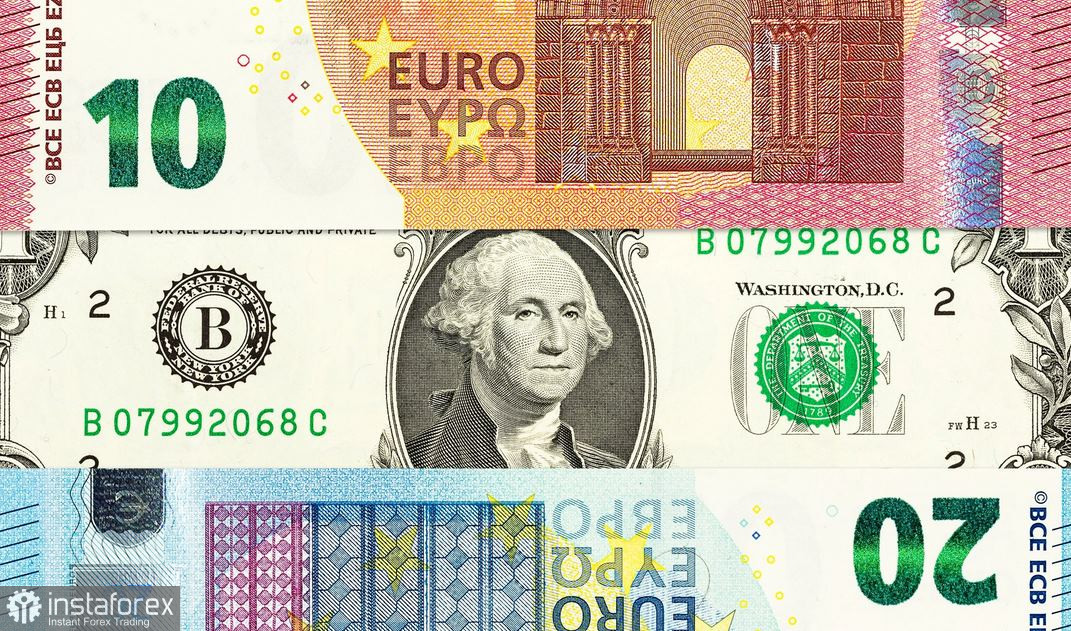The EUR/USD pair has gained a foothold in the area of the 99th figure, demonstrating a large-scale corrective growth. It should be emphasized at once that the upward dynamics of the price is mainly due not to the strengthening of the euro, but to the weakening of the US currency. The US dollar index is actively losing its positions amid rising risk sentiment in the market, a decrease in the yield of treasuries, as well as amid the decline in hawkish expectations about the Federal Reserve's further actions. All of these fundamental factors are related in one way or another, but none of them supports the euro. As soon as the dollar completes the correction, the EUR/USD downward trend will resume again. Under the current conditions, the euro will not be able to pick up the falling banner, turning the situation in its favor. Consequently, longs for the pair still look risky, despite the rapid and, at first glance, categorical rise of EUR/USD.

So, why has the dollar become actively cheaper this week? If we talk about the chronology of events, then it is necessary first of all to mention the ISM manufacturing index, which was published in America on Monday. The release was frankly disappointing. Firstly, the indicator came out in the red zone: with a forecast of growth up to 52 points, the index came out at 50.2. Secondly, the indicator updated a two-year low, recording the weakest result since May 2020. Thirdly, the index has come close to the 50.0 mark. The last time the indicator was below this target was only during the first wave of the coronavirus crisis. In other words, the release disappointed "by all accounts", putting pressure on the dollar. The stock market also reacted to the report. Key Wall Street indexes registered a steady increase on Monday and recorded impressive growth. By the way, Tuesday's trading also opened with growth, amid a decrease in the yield of US Treasury bonds.
Of course, the index itself does not have such significance. Monday's report was the trigger that fueled further processes. The ISM report showed that price pressure in the manufacturing sector continues to weaken, and the employment component has decreased uncritically. Such results led to unexpected conclusions that the Fed may "moderate its ardor" in the context of further rates of monetary policy tightening. Thus, according to the CME Group FedWatch Tool, the probability of another interest rate hike by 75 basis points at the November meeting decreased to 50% after the release of the report. Amid such dynamics, the profitability of treasuries has also decreased. In particular, the yield of 10-year bonds was trading with a 2% intraday drawdown on Tuesday after the previous day's decline of almost 5%.
Such a fundamental background contributes to the weakening of the US currency, especially after the sharp September rise across the market. The euro as a whole remains under pressure. However, it received a bit of support from European Central Bank representative Francois Villeroy de Galo (head of the central bank of France), who said that interest rates "will rise as much as necessary to reduce core inflation." And although he clarified that the pace of monetary policy tightening would slow down next year, traders focused on Galo's hawkish theses. His comments allowed EUR/USD bulls to develop an upward momentum and gain a foothold within the 99 figure.
I consider the current price growth as the development of a corrective pullback after the pair's decline to a 20-year low of 0.9537. The aforementioned fundamental factors that provoked this correction, in my opinion, are of a shaky nature. If the Fed representatives continue (for the most part) to insist on a 75-point hike in November, the greenback will quickly regain its position. The probability of this scenario is quite high, given the renewed growth of the PCE index and the continued growth of the consumer price index in the United States.
At the moment, it is advisable to take a wait-and-see position for the EUR/USD pair, until the end of the corrective upward pullback. The pair is located on the middle line of the Bollinger Bands indicator on the daily chart, above the Tenkan-sen and Kijun-sen lines, but under the Kumo cloud. You can consider short positions on the pair after the price returns under the middle line of the Bollinger Bands at D1 (0.9890). In this case, the first target of the bearish movement will be the 0.9750 mark – this is the Tenkan-sen line on the same timeframe.
 English
English 
 Русский
Русский Bahasa Indonesia
Bahasa Indonesia Bahasa Malay
Bahasa Malay ไทย
ไทย Español
Español Deutsch
Deutsch Български
Български Français
Français Tiếng Việt
Tiếng Việt 中文
中文 বাংলা
বাংলা हिन्दी
हिन्दी Čeština
Čeština Українська
Українська Română
Română

